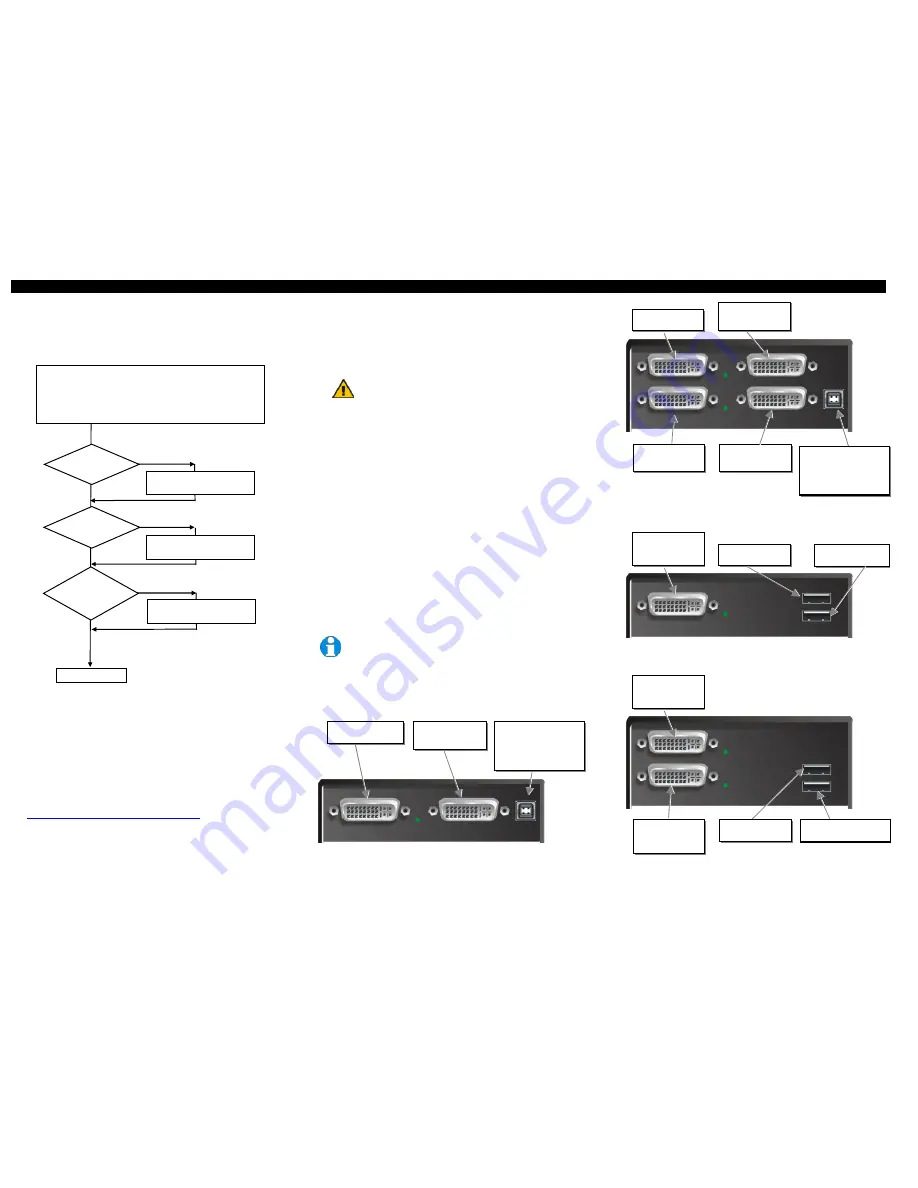
DVI-D KVM EXTENDER-PC DVI- KVM-EXTENDER
DVI-D KVM EXTENDER-PC DVI- KVM-EXTENDER
DVI-D KVM EXTENDER-PC DVI- KVM-EXTENDER
1 Quick Setup
This section briefly describes how to install your KVM extender system. Unless you are an
experienced user, we recommend that you follow the full procedures described in the rest of this
manual..
2 Installation
For first-time users, we recommend that you carry out a test placement, confined to a single room,
before commencing full installation. This will allow you to identify and solve any cabling problems,
and experiment with the KVM extender system more conveniently.
2.1 Package Contents
You should receive the following items in your extender package (all types):
•
DVI-D KVM Extender KVM-Extender- pair (Local Unit + Remote Unit)
•
2x 5V DC universal power supply for the DVI-D KVM Extender - Extender
•
2x German type power cord
•
Quick Install Guide (A user manual can be obtained from
(
ftp://ftp.blackbox.com/manuals/ACS/ACS1009A_Manual.pdf
)
•
KVM CPU cable set (1.8m) consisting of 1,8m USB-A/B cable and 1.8m DVI-D M/M cable
ACS4201A (additionally):
•
1.8m DVI-D M/M cable
If anything is missing, please contact Technical Support
2.2 System Setup
To install your DVI-D KVM Extender – Extender system:
1.
Switch off all devices.
2.
Connect your keyboard, monitor(s) and mouse to the Remote unit.
3.
Using the supplied CPU KVM cable(s), connect the USB and monitor(s) connectors on the
computer (or KVM switch).
4.
Connect the interconnect cable to the INTERCONNECT socket(s)
5.
Connect the 5V power supply to power the unit.
Only use the power supply originally supplied with this
equipment or a manufacturer-approved replacement.
6.
For a dual access system, connect the USB (keyboard, mouse) and monitor for the Local
console to the appropriate ports on the Local unit. The ports may also be used to feed into a
KVM switch. For dual access, you may feed your local monitor into the DVI-D output
connector at the local unit. To attach a second keyboard/mouse, please use additional USB
port(s) at your CPU or use a USB Hub inbetween CPU and local unit’s USB connector.
7.
Power up the system.
2.3 Interconnection Cable Requirements
To connect the Local and Remote units you will need:
•
DVI, USB-Keyboard, USB-Mouse:
Connect the supplied KVM CPU cable set to your CPU
(KVM.- Switch, etc.). Please ensure that the connection is tension-free! Devices AC
ACS4201A
•
DVI:
Connect the supplied DVI CPU cable set to your CPU (KVM.- Switch, etc.). Please
ensure that the connection is tension-free! Devices ACS4201A
•
CATx Cable:
Recommended cable: S/UTP (Cat5) according EIA/TIA 56A, TSB 36 or Digital
STP 17-03170. Four pairs AWG 24. connection according EIA/TIA 568A (10BaseT). Use of
cables from a higher category (Cat5e, Cat6, Cat7) is possible.
The use of unshielded CATx Cable is possible, because of the higher electromagnetic
noise/sensitivity the device class may not be reached.
The use of flexible Cables (Patch cable) Type AWG26/8 is possible. Because of the higher loss
of the stranded cables, the maximum distance is reduced to app. half the value of solid cables.
A point to point connection is required. Having one or more patch panels in the
line is possible and allowed. Not allowed is a connection from the CATx link
interface (RJ45) to any other products, especially telecommunications or network
equipment.
3 Device view (depending on device type)
DVI-D KVM Extender KVM-Extender Type ACS4001A Local Unit
DVI-D KVM Extender KVM-Extender Type ACS4201A Local Unit
DVI-D KVM Extender KVM-Extender Type ACS4001A Remote Unit
DVI-D KVM Extender KVM-Extender Type ACS4201A Remote Unit
remote DVI-Monitor
port– connect to
Remote console
monitor
Remote
keyboard/mouse port
Remote
keyboard/mouse port
Connect to CPU:
2
nd
DVI-Graphic card
2
nd
local DVI-Monitor
port Connect to Local
console 2
nd
monitor
Connect to CPU:
1
st
DVI-Graphic card
local DVI-Monitor port
Connect to Local
console monitor
Connect to CPU:
USB (keyboard/ mouse)
Solely keyboard/mouse are
supported or other HID
devices
2
nd
remote DVI-
Monitor port Connect
to Remote console
2
nd
monitor
1
st
remote DVI-
Monitor port– connect
to Remote console 1
st
monitor
Remote
keyboard/mouse port
Remote keyboard/mouse
port
Install system
1.
Connect Remote unit to KVM.
2.
Connect Local unit to CPU or switch.
3.
Connect Local and Remote units with matching interconnection cable
(CATx).
4.
Power up the system.
Done
YES
NO
Link
LED
illuminated ?
NO
NO
YES
Check p.s.u.’s and connection
to power outlet
Power
LED
illuminated?
Check the CATx cable, and
CATx connectors
Check settings of graphic card
or boot CPU
Video OK
LED ?
illuminated ?
YES
Connect to CPU:
DVI
local DVI-Monitor port
Connect to Local
console monitor
Connect to CPU:
USB (keyboard/ mouse)
Solely keyboard/mouse are
supported or other HID
devices


